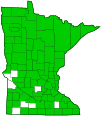spreading dogbane
(Apocynum androsaemifolium)
Conservation • Wetland • Description • Habitat • Ecology • Use • Distribution • Taxonomy
Description |
Spreading dogbane is an erect perennial rising from a fibrous rhizome, often forming colonies. It may take the form of an erect but inclined, branched stem, or it may be many-branched, in which case there is no central stem. The stems and leaves contain a milky juice. The stems are usually red or tinged with red. Leaves are opposite, untoothed, and egg-shaped or roughly egg-shaped but two or more times as long as wide with more or less straight sides. They are 1⅓″ to 3½″ long and droop downward from the stem on short leaf stalks. They are tipped with a sharp, slender point. The upper surface is hairless and dark green. The underside is pale is usually hairy. The inflorescence is a branched cluster with many flowers at the end of each stem and branched clusters with fewer flowers from the upper leaf axils. It usually extends beyond the leaves. The flowers are ¼″ to ⅜″ wide, fragrant, and nodding on flower stalks that are just over ⅛″ long. The 5 petals are united at the base to form a bell shaped cylinder with 5 lobes. They are pale pink with dark pink vertical stripes. The lobes spread or curve backward strongly at their tips. The fruit is a pair of 3″ to 5½″ long slender seed pods. |
Height |
8″ to 32″ |
Flower Color |
Pale pink with dark pink veins |
Similar Species |
Indian hemp (Apocynum cannabinum) is a taller plant. The leaves are usually erect or ascending, sometimes widely spreading. The inflorescence usually does not extend beyond the leaves. The flower is smaller, urn-shaped, and white or greenish white with no pink stripes. The corolla lobes are erect to spreading and do not curve backward. |
Habitat |
Borders of upland woods, occasionally in fields and roadsides. Full sun. |
Ecology |
Flowering |
June to August |
Pests and Diseases |
|
Use |
|
Distribution |
||
|
Sources 2, 3, 5, 7, 8, 22, 24, 28, 29, 30. Biodiversity occurrence data published by: Minnesota Biodiversity Atlas (accessed through the Minnesota Biodiversity Atlas Portal, bellatlas.umn.edu, 7/11/2025). |
|
| 7/11/2025 | ||
Nativity |
||
Native |
||
Occurrence |
||
Common |
||
Taxonomy |
|
Kingdom |
|
Division |
Tracheophyta (Vascular Plants) |
Subdivision |
Spermatophytina (Seed Plants) |
Class |
|
Order |
Gentianales (Gentians, Dogbanes, Madders, and Allies) |
Family |
Apocynaceae (dogbane) |
Subfamily |
Apocynoideae |
Tribe |
Apocyneae |
Subtribe |
Apocyinae |
Genus |
Apocynum (dogbanes) |
Subordinate Taxa |
|
spreading dogbane (Apocynum androsaemifolium ssp. androsaemifolium) spreading dogbane (Apocynum androsaemifolium ssp. pumilum) spreading dogbane (Apocynum androsaemifolium var. grisium) spreading dogbane (Apocynum androsaemifolium var. incanum) spreading dogbane (Apocynum androsaemifolium var. intermedium) spreading dogbane (Apocynum androsaemifolium var. tomentellum) spreading dogbane (Apocynum androsaemifolium var. woodsonii) |
|
Synonyms |
|
Apocynum ambigens Apocynum androsaemifolium var. androsaemifolium Apocynum androsaemifolium var. glabrum Apocynum pumilum Apocynum pumilum var. rhomboideum Apocynum scopulorum |
|
Common Names |
|
bitter dogbane bitter-root bitterroot common dogbane dogbane dogsbane flytrap dogbane honey-bloom low dogbane milk ipecac mountain dogbane smooth mountain dogbane spreading dogbane wandering milkweed |
|
Glossary
Axil
The upper angle where the leaf stalk meets the stem.
Corolla
A collective name for all of the petals of a flower.
Rhizome
A horizontal, usually underground stem. It serves as a reproductive structure, producing roots below and shoots above at the nodes.
Visitor Photos |
||
Share your photo of this plant. |
||
This button not working for you? |
||
Dan W. Andree |
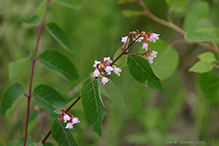 |
| Flowering shrub |
Greg Watson |
 |
MinnesotaSeasons.com Photos |
||
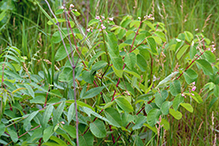 |
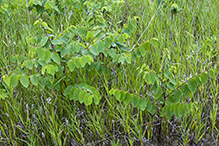 |
|
Plant |
Plant |
|
|
||
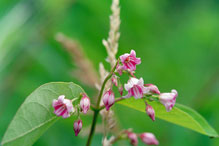 |
||
Inflorescence |
|
|
|
||
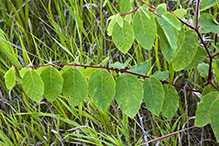 |
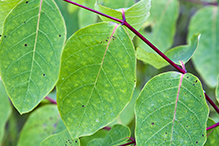 |
|
Leaves |
Leaves |
|

Slideshows |
Dogbane |
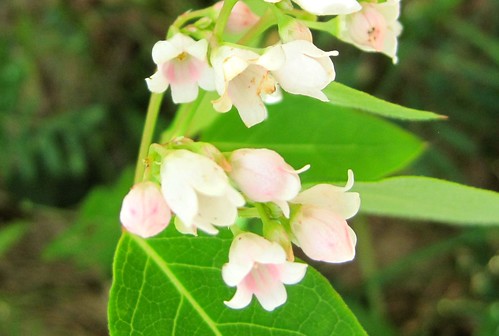
|
About
Copyright DianesDigitals |
Spreading Dogbane |
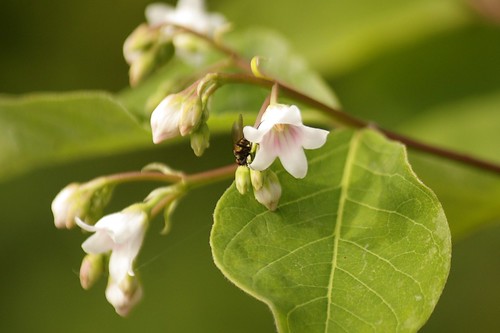
|
About
Apocynum androsaemifolium Information from USDA NRCS National Plant Data Center (pdf): Alternate Names: Dogbane, milkweed, honeybloom, bitter root, black hemp, hemp dogbane, lechuguilla, westernwall Uses Ethnobotanic: Indian hemp is harvested for fiber. The stems are cut in the fall; they are then split open and the long, silky fibers removed. The fibers are then twisted into string, which provides cordage. String, thread, rope, baskets, snares, netting, and clothing were made from the bast fibers of the Indian hemp plant because they are so silky yet strong. Cordage was then used to make tump straps, belts, netted bags, hairnets, and ceremonial regalia (capes, skirts, and head-dresses). The fiber was particularly useful in making fishing and carrying nets, for string and for ropes, and to some extent for weaving rough cloth. In California, Indian hemp and milkweed are used somewhat interchangeably for cordage. The Luiseño of southern California for their dance regalia used Indian hemp; the golden eagle or other feathers are tied to netting for the dance skirt for men (Merriam 1955). The wild hemp was also used by the Chemeweve for snares for otter and rabbits (Ibid.) Dogbane is very important to tribes in the Columbia Plateau in Washington, Oregon, and Idaho for basketry. The Quinalt, Kalispel, Nez Perce, Spokane, Umatilla, Wasco, Wishram, Yakima, and Klikitat used dogbane for cordage and basketry. Families use the native twine to tie together the frames for their winter lodges. They used it to sew cattails and tules into sturdy mats to cover these frames and to serve as carpeting, furniture, beds, and utensils. Dip nets, set nets, and seines were made of dogbane. The nets were strong enough to hold the giant sturgeon caught in the Columbia River. Of all the important uses for Indian hemp, the itatamat , or "counting the days" ball, was perhaps the most significant for the people themselves. From the time of her marriage, a woman would record a calendar of her life's events by tying knots on a length of hemp as important events occurred. She marked births, deaths, and other extraordinary days with beads, shells or other talismans. When the ball got too large to handle easily, she started a new ball. Flat twined bags ("sally bags"), round twined bags and basketry caps were made with dogbane. Soft bags were made using twine from Indian hemp or milkweed decorated with cornhusk imbrication. Basket bottoms and top margins were of woven cedar bark. These soft bags conform to the shape of a load of roots of camas or other plants. Later explorers reported that the Nez Perce and other tribes stored berries, roots, and nuts in bags about one by two feet, and used larger bags up to three feet long for clothing and other personal effects. Early visitor to the Mid-Columbia also described piles of filled bags in the corners or hung along the wall in native homes. One weaver estimated that it took two to three months to twine a large root-storage bag. As a medium of trade, barter, or wager, the bags in the early days were considered only the wrapping or container for the dried roots they held. The largest of the bags would hold just under a half-bushel or nearly four dry gallons of camas or bitterroot bulbs. Now, the bags themselves are highly valued as trade items. The flat twined bags have been widely traded to other tribes, such as the Crow and Blackfeet of Montana. |

Visitor Videos |
||
Share your video of this plant. |
||
This button not working for you? |
||
|
Other Videos |
||
Poison Plant series- Spreading Dogbane 1.wmv |
About
Uploaded on Jun 7, 2010 This is the start of my Poison Plant series in which I begin by discussing the Spreading Dogbane. It is to compliment my wild edible series. |
Spreading Dogbane...Mid-Summer Butterfly Nectar Source |
About
Published on Jul 27, 2014 Recently discovered a wildflower that provides abundant nectar for large concentrations of Fritillaries et al. |
Werewolf root with Matthew Wood |
About
Published on Aug 11, 2014 In this video Matthew Wood teaches about the herbal uses of spreading dogbane - known by Native Americans as werewolf root. |

Visitor Sightings |
||
Report a sighting of this plant. |
||
This button not working for you? |
||
Dan W. Andree |
Location: Frenchman’s Bluff SNA Flowering shrub |
 |
| Greg Watson 8/21/2023 |
Location: Magelssen Bluff Park |
 |
MinnesotaSeasons.com Sightings |
||
Badoura Jack Pine Woodland SNA Carpenter St. Croix Valley Nature Center Forestville/Mystery Cave State Park Itasca Wilderness Sanctuary SNA Kellogg Weaver Dunes SNA, Kellogg Weaver Unit Lake Alexander Woods SNA, South Unit Margherita Preserve-Audubon Prairie Minnesota Valley NWR, Chaska Unit Minnesota Valley NWR, Wilkie Unit |

Created 7/23/2006 Last Updated: © MinnesotaSeasons.com. All rights reserved. |
